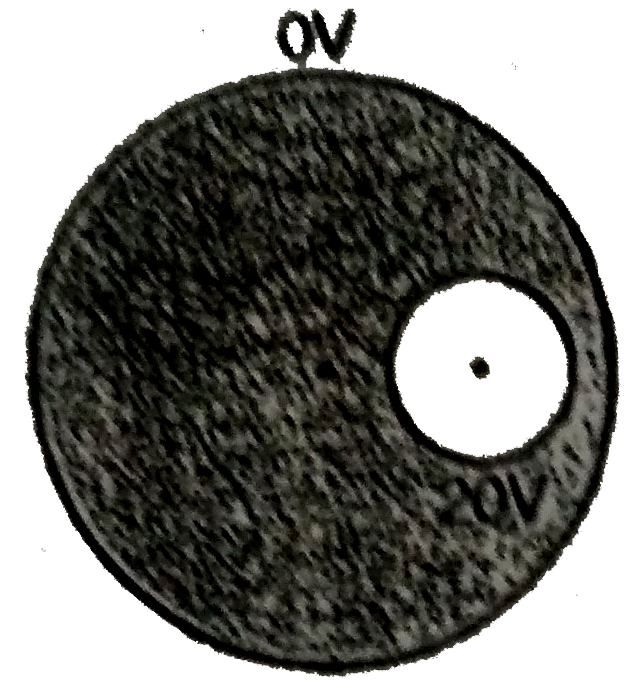Angle between equipotential surface and lines of force is
zero
180∘
90∘
45∘
The correct Answer is:C
To solve the question regarding the angle between equipotential surfaces and lines of force, we can follow these steps:
1. Understanding Equipotential Surfaces:
- Equipotential surfaces are defined as surfaces where the electric potential is constant. This means that if you move along an equipotential surface, there is no change in electric potential (ΔV = 0).
2. Understanding Electric Field Lines:
- Electric field lines represent the direction of the electric field. The electric field (E) points in the direction in which a positive test charge would move.
3. Analyzing the Angle:
- Let's denote the angle between the electric field lines and the equipotential surface as θ.
- If the electric field makes an angle θ with the normal (perpendicular) to the equipotential surface, we can analyze the components of the electric field.
4. Components of Electric Field:
- The electric field can be resolved into two components: one parallel to the equipotential surface (E_parallel = E cos θ) and one perpendicular to the equipotential surface (E_perpendicular = E sin θ).
5. Condition for Equipotential Surface:
- For the surface to remain equipotential, the potential must not change as you move along the surface. This means that the component of the electric field parallel to the surface (E_parallel) must be zero.
- Therefore, we have:
Ecosθ=0
- The only way for this equation to hold true is if cos θ = 0, which occurs when θ = 90 degrees.
6. Conclusion:
- Hence, the angle between the equipotential surface and the electric field lines (lines of force) is 90 degrees. This means that the electric field lines are always perpendicular to the equipotential surfaces.
Final Answer:
The angle between equipotential surfaces and lines of force is 90 degrees.
---
- Equipotential surfaces are defined as surfaces where the electric potential is constant. This means that if you move along an equipotential surface, there is no change in electric potential (ΔV = 0).
- Electric field lines represent the direction of the electric field. The electric field (E) points in the direction in which a positive test charge would move.
- Let's denote the angle between the electric field lines and the equipotential surface as θ.
- If the electric field makes an angle θ with the normal (perpendicular) to the equipotential surface, we can analyze the components of the electric field.
- The electric field can be resolved into two components: one parallel to the equipotential surface (E_parallel = E cos θ) and one perpendicular to the equipotential surface (E_perpendicular = E sin θ).
- For the surface to remain equipotential, the potential must not change as you move along the surface. This means that the component of the electric field parallel to the surface (E_parallel) must be zero.
- Therefore, we have:
Ecosθ=0
- The only way for this equation to hold true is if cos θ = 0, which occurs when θ = 90 degrees.
- Hence, the angle between the equipotential surface and the electric field lines (lines of force) is 90 degrees. This means that the electric field lines are always perpendicular to the equipotential surfaces.
The angle between equipotential surfaces and lines of force is 90 degrees.
Topper's Solved these Questions
- ELECTROSTATIC POTENTIAL AND CAPACITORSBOOK - DC PANDEY ENGLISHCHAPTER - ELECTROSTATIC POTENTIAL AND CAPACITORSEXERCISE - (B) Chapter exercises
17 Videos
- ELECTROSTATIC POTENTIAL AND CAPACITORSBOOK - DC PANDEY ENGLISHCHAPTER - ELECTROSTATIC POTENTIAL AND CAPACITORSEXERCISE - (C) Chapter exercises
50 Videos
- ELECTROSTATIC POTENTIAL AND CAPACITORSBOOK - DC PANDEY ENGLISHCHAPTER - ELECTROSTATIC POTENTIAL AND CAPACITORSEXERCISE - Check point 2.5
20 Videos
- ELECTROMAGNETIC WAVESBOOK - DC PANDEY ENGLISHCHAPTER - ELECTROMAGNETIC WAVESEXERCISE - Sec C
22 Videos
- ELECTROSTATICSBOOK - DC PANDEY ENGLISHCHAPTER - ELECTROSTATICSEXERCISE - Medical entrances gallery
37 Videos
Similar Questions
Knowledge Check
Equipotential surfaces
Aare closer in regions of large electric fields compared to regions of lower electric fieldsBwill be more crowded near sharp edges of a conductorCwill always be equally spacedDboth (a) and (b) are correctThe angle between the equipotential surface and the electric field (or line of force) at any point on the equipotential surface is
A90∘ alwaysB0∘ alwaysC0∘ to 90∘D0∘ to 180∘
An infinite sheet of charge has surface charge density σ . The separation between two equipotential surfaces, whose potential differ by V is:
View SolutionNature of equipotential surface for a point charge is
View SolutionTwo equipotential spherical surface having potential 20V and 0V are as shown in figure. There is no charge anywhere in space except on the surface of both the spheres. Then which of the following figure represents the nature of electric field in region between the spherical surfaces by electric lines of forces.

View SolutionTwo equipotential spherical surface having potential 20V and 0V are as shown in figure. There is no charge anywhere in space except on the surface of both the spheres. Then which of the following figure represents the nature of electric field in region between the spherical surfaces by electric lines of forces.

View SolutionCan two equipotential surfaces cut each other?
View Solution(a) Draw the equipotential surfaces corresponding to a uniform electric field in the z-direction.
(b) Derive an expression for the electric potential at any point along the axial line of an electric dipole
View Solution
